The Influence of COVID-19-Induced Daily Activities on Health Parameters—A Case Study in Malaysia
Abstract
:1. Introduction
2. Methods and Materials
2.1. Study Area
2.2. The Survey
3. Exploratory Analysis and Discussion
3.1. Physical Activities at Socio-Demographic Level
3.2. Daily Time-Use and Health Parameters
4. Model Estimation Results
- Strenuous and moderate-intensity PA at work/job, physical and social health
- Strenuous and moderate-intensity PA at leisure time, physical and social health
5. Conclusions
Author Contributions
Funding
Institutional Review Board Statement
Informed Consent Statement
Data Availability Statement
Acknowledgments
Conflicts of Interest
References
- Ghebreyesus, T.A. WHO Director-General’s Opening Remarks at the Media Briefing on COVID-19-11 March 2020; World Health Organization: Geneva, Switzerland, 2020; Available online: https://www.who.int/director-general/speeches/detail/who-director-general-s-opening-remarks-at-the-media-briefing-on-covid-19---11-march-2020 (accessed on 29 June 2021).
- Spina, S.; Marrazzo, F.; Migliari, M.; Stucchi, R.; Sforza, A.; Fumagalli, R. The Response of Milan’s Emergency Medical System to the COVID-19 Outbreak in Italy. Lancet 2020, 395, e49–e50. [Google Scholar] [CrossRef] [Green Version]
- Aristovnik, A.; Keržič, D.; Ravšelj, D.; Tomaževič, N.; Umek, L. Impacts of the COVID-19 Pandemic on Life of Higher Education Students: A Global Perspective. Sustainability 2020, 12, 8438. [Google Scholar] [CrossRef]
- Elengoe, A. COVID-19 Outbreak in Malaysia. Osong Public Health Res. Perspect. 2020, 11, 93–100. [Google Scholar] [CrossRef]
- Times, N.S. [Breaking] 3 Coronavirus Cases Confirmed in Johor Baru, In Internet. 2020. Available online: https://www.nst.com.my/news/nation/2020/01/559563/breaking-3-coronavirus-cases-confirmed-johor-baru (accessed on 29 June 2021).
- First Coronavirus Cases in Malaysia: 3 Chinese Nationals Confirmed Infected, Quarantined in Sungai Buloh Hospital. 2020. Available online: https://www.theborneopost.com/2020/01/25/first-coronavirus-cases-in-malaysia-3-chinese-nationals-confirmed-infected-quarantined-in-sungai-buloh-hospital/ (accessed on 29 June 2021).
- Chinese Girl Recovers from Coronavirus, Discharged from Hospital. 2020. Available online: https://www.bernama.com/en/general/news.php?id=1811559 (accessed on 29 June 2021).
- Yassin, M. Coronavirus: Malaysia in Partial Lockdown from March 18 to Limit Outbreak. 2020. Available online: https://www.scmp.com/week-asia/health-environment/article/3075456/coronavirus-malaysias-prime-minister-muhyiddin-yassin (accessed on 29 June 2021).
- Tang, K.H.D. Movement Control as an Effective Measure Against Covid-19 Spread in Malaysia: An Overview. J. Public Health 2020, 1–4. [Google Scholar] [CrossRef]
- Shah, A.U.M.; Safri, S.N.A.; Thevadas, R.; Noordin, N.K.; Rahman, A.A.; Sekawi, Z.; Ideris, A.; Sultan, M.T.H. COVID-19 Outbreak in Malaysia: Actions Taken by the Malaysian Government. Int. J. Infect. Dis. 2020, 97, 108–116. [Google Scholar] [CrossRef]
- Yau, E.K.B.; Ping, N.P.T.; Shoesmith, W.D.; James, S.; Hadi, N.M.N.; Lin, L.J.; Clinic, C.A.N.W.L.N.F.T.Q. The Behaviour Changes in Response to COVID-19 Pandemic within Malaysia. Malays. J. Med. Sci. 2020, 27, 45–50. [Google Scholar] [CrossRef]
- Gonzalez, T.; De La Rubia, M.A.; Hincz, K.P.; Comas-Lopez, M.; Subirats, L.; Fort, S.; Sacha, G.M. Influence of COVID-19 Confinement on Students’ Performance in Higher Education. PLoS ONE 2020, 15, e0239490. [Google Scholar] [CrossRef]
- Aucejo, E.M.; French, J.; Araya, M.P.U.; Zafar, B. The Impact of COVID-19 on Student Experiences and Expectations: Evidence from a Survey. J. Public Econ. 2020, 191, 104271. [Google Scholar] [CrossRef]
- Cao, W.; Fang, Z.; Hou, G.; Han, M.; Xu, X.; Dong, J.; Zheng, J. The Psychological Impact of the COVID-19 Epidemic on College Students in China. Psychiatry Res. 2020, 287, 112934. [Google Scholar] [CrossRef] [PubMed]
- Maugeri, G.; Castrogiovanni, P.; Battaglia, G.; Pippi, R.; D’Agata, V.; Palma, A.; Di Rosa, M.; Musumeci, G. The Impact of Physical Activity on Psychological Health during Covid-19 Pandemic in Italy. Heliyon 2020, 6, e04315. [Google Scholar] [CrossRef]
- Pragholapati, A. COVID-19 Impact on Students. 2020. Available online: https://edarxiv.org/895ed/ (accessed on 29 June 2021).
- Sahu, P. Closure of Universities Due to Coronavirus Disease 2019 (COVID-19): Impact on Education and Mental Health of Students and Academic Staff. Cureus 2020, 12, e7541. [Google Scholar] [CrossRef] [PubMed] [Green Version]
- Ali, M.; Abbas, S.; Khan, M.I.; Gad, M.A.; Ammad, S.; Khan, A. Experimental Validation of Mander’s Model for Low Strength Confined Concrete Under Axial Compression. In Proceedings of the 2020 Second International Sustainability and Resilience Conference: Technology and Innovation in Building Designs(51154), Sakheer, Bahrain, 11–12 November 2020. [Google Scholar] [CrossRef]
- Marelli, S.; Castelnuovo, A.; Somma, A.; Castronovo, V.; Mombelli, S.; Bottoni, D.; Leitner, C.; Fossati, A.; Ferini-Strambi, L. Impact of COVID-19 Lockdown on Sleep Quality in University Students and Administration Staff. J. Neurol. 2021, 268, 8–15. [Google Scholar] [CrossRef] [PubMed]
- Carter, S.J.; Baranauskas, M.N.; Fly, A.D. Considerations for Obesity, Vitamin D, and Physical Activity Amid the COVID-19 Pandemic. Obesity 2020, 28, 1176–1177. [Google Scholar] [CrossRef] [PubMed]
- Cheval, B.; Sivaramakrishnan, H.; Maltagliati, S.; Fessler, L.; Forestier, C.; Sarrazin, P.; Orsholits, D.; Chalabaev, A.; Sander, D.; Ntoumanis, N.; et al. Relationships between Changes in Self-Reported Physical Activity, Sedentary Behaviour and Health during the Coronavirus (COVID-19) Pandemic in France and Switzerland. J. Sports Sci. 2021, 39, 699–704. [Google Scholar] [CrossRef] [PubMed]
- Dwyer, M.J.; Pasini, M.; De Dominicis, S.; Righi, E. Physical Activity: Benefits and Challenges during the COVID-19 Pandemic. Scand. J. Med. Sci. Sports 2020, 30, 1291–1294. [Google Scholar] [CrossRef] [PubMed]
- Jakobsson, J.; Malm, C.; Furberg, M.; Ekelund, U.; Svensson, M. Physical Activity during the Coronavirus (COVID-19) Pandemic: Prevention of a Decline in Metabolic and Immunological Functions. Front. Sports Act. Living 2020, 2, 57. [Google Scholar] [CrossRef] [PubMed]
- Hammami, A.; Harrabi, B.; Mohr, M.; Krustrup, P. Physical Activity and Coronavirus Disease 2019 (COVID-19): Specific Recommendations for Home-Based Physical Training. Manag. Sport Leis. 2020, 1–6. [Google Scholar] [CrossRef]
- Ali, M.; Room, S.; Khan, M.I.; Masood, F.; Memon, R.A.; Khan, R.; Memon, A.M. Assessment of Local Earthen Bricks in Perspective of Physical and Mechanical Properties Using Geographical Information System in Peshawar, Pakistan. Structues 2020, 28, 2549–2561. Available online: https://www.sciencedirect.com/science/article/pii/S2352012420306329 (accessed on 29 June 2021). [CrossRef]
- Shahidi, S.H.; Williams, J.S.; Hassani, F. Physical Activity during COVID-19 Quarantine. Acta Paediatr. 2020, 109, 2147–2148. [Google Scholar] [CrossRef]
- Woods, J.A.; Hutchinson, N.T.; Powers, S.K.; Roberts, W.O.; Gomez-Cabrera, M.C.; Radak, Z.; Berkes, I.; Boros, A.; Boldogh, I.; Leeuwenburgh, C.; et al. The COVID-19 Pandemic and Physical Activity. Sports Med. Health Sci. 2020, 2, 55–64. Available online: https://www.sciencedirect.com/science/article/pii/S2666337620300251 (accessed on 29 June 2021). [CrossRef]
- Zhang, J. Urban Forms and Health Promotion: An Evaluation Based on Health-Related QOL Indicators. In Proceedings of the 13th World Conference on Transportation Research, Rio de Janeiro, Brazil, 15–18 July 2013. [Google Scholar]
- Van Wee, B.; Ettema, D. Travel Behaviour and Health: A Conceptual Model and Research Agenda. J. Transp. Health 2016, 3, 240–248. [Google Scholar] [CrossRef] [Green Version]
- Barreto, E.D.; Stafanato, K.V.; Marvila, M.T.; De Azevedo, A.; Ali, M.; Pereira, R.; Monteiro, S.N. Clay Ceramic Waste as Pozzolan Constituent in Cement for Structural Concrete. Materials 2021, 14, 2917. [Google Scholar] [CrossRef]
- Israel, G.D. Determining Sample Size. 1992. Available online: https://www.researchgate.net/profile/Subhash-Basu-3/post/how_could_i_determine_sample_size_for_my_study/attachment/5ebaa4924f9a520001e613b6/AS%3A890361492811785%401589290130539/download/samplesize1.pdf (accessed on 29 June 2021).
- Krejcie, R.V.; Morgan, D.W. Determining Sample Size for Research Activities. Educ. Psychol. Meas. 1970, 30, 607–610. [Google Scholar] [CrossRef]
- Axhausen, K.W.; Zimmermann, A.; Schönfelder, S.; Rindsfüser, G.; Haupt, T. Observing the Rhythms of Daily Life: A Six-Week Travel Diary. Transportation 2002, 29, 95–124. [Google Scholar] [CrossRef]
- Suzukamo, Y.; Fukuhara, S.; Green, J.; Kosinski, M.; Gandek, B.; Ware, J.E. Validation Testing of a Three-Component Model of Short Form-36 Scores. J. Clin. Epidemiol. 2011, 64, 301–308. Available online: https://www.ncbi.nlm.nih.gov/pubmed/20800993 (accessed on 29 June 2021). [CrossRef]
- DiStefano, C.; Zhu, M.; Mindrila, D. Understanding and Using Factor Scores: Considerations for the Applied Researcher. Pract. Asses. Res. Eval. 2009, 14, 20. [Google Scholar] [CrossRef]
- Yong, A.G.; Pearce, S. A Beginner’s Guide to Factor Analysis: Focusing on Exploratory Factor Analysis. Tutor. Quant. Methods Psychol. 2013, 9, 79–94. [Google Scholar] [CrossRef]
- Rhodes, R.E.; Blanchard, C.M.; Blacklock, R.E. Do Physical Activity Beliefs Differ by Age and Gender? J. Sport Exerc. Psychol. 2008, 30, 412–423. [Google Scholar] [CrossRef]
- Azevedo, M.R.; Araújo, C.L.P.; Reichert, F.F.; Siqueira, F.V.; Da Silva, M.C.; Hallal, P.C. Gender Differences in Leisure-Time Physical Activity. Int. J. Public Health 2007, 52, 8–15. [Google Scholar] [CrossRef] [Green Version]
- Kenyon, S. What Do We Mean by Multitasking?-Exploring the Need for Methodological Clarification in Time Use Research. Electron. Int. J. Time Use Res. 2010, 7, 42–60. [Google Scholar] [CrossRef]
- Hodgson, S.; Namdeo, A.; Araújo-Soares, V.; Pless-Mulloli, T. Towards an Interdisciplinary Science of Transport and Health: A Case Study on School Travel. J. Transp. Geogr. 2012, 21, 70–79. [Google Scholar] [CrossRef] [Green Version]
- Lacy, K.E.; Allender, S.E.; Kremer, P.J.; De Silva-Sanigorski, A.M.; Millar, L.M.; Moodie, M.L.; Mathews, L.B.; Malakellis, M.; Swinburn, B.A. Screen Time and Physical Activity Behaviours are Associated with Health-Related Quality of Life in Australian Adolescents. Qual. Life Res. 2012, 21, 1085–1099. Available online: https://www.ncbi.nlm.nih.gov/pubmed/21932139 (accessed on 29 June 2021). [CrossRef]
- DiPietro, L. Physical Activity in Aging: Changes in Patterns and Their Relationship to Health and Function. J. Gerontol. Ser. A Boil. Sci. Med. Sci. 2001, 56 (Suppl. 2), 13–22. [Google Scholar] [CrossRef]
- Roberts, R.; Golding, J.; Towell, T.; Reid, S.; Woodford, S.; Vetere, A.; Weinreb, I. Mental and Physical Health in Students: The Role of Economic Circumstances. Br. J. Health Psychol. 2000, 5, 289–297. [Google Scholar] [CrossRef]
- Zemitis, J.; Bogdanovics, R.; Bogdanovica, S. The Study of Co2 Concentration in A Classroom During The Covid-19 Safety Measures. In E3S Web of Conferences; EDP Sciences: Les Ulis, France, 2021. [Google Scholar]
- Fediuk, R. High-strength Fibrous Concrete of Russian Far East Natural Materials. IOP Conf. Ser. Mater. Sci. Eng. 2016, 116, 012020. [Google Scholar] [CrossRef] [Green Version]
- Chernysheva, N.V.; Lesovik, V.S.; Drebezgova, M.Y.; Shatalova, S.V.; Alaskhanov, A.H. Composite Gypsum Binders with Silica-containing Additives. IOP Conf. Ser. Mater. Sci. Eng. 2018, 327, 032015. [Google Scholar] [CrossRef]
- Lum, T.Y.; Lightfoot, E. The Effects of Volunteering on the Physical and Mental Health of Older People. Res. Aging 2005, 27, 31–55. [Google Scholar] [CrossRef]
- De Hartog, J.J.; Boogaard, H.; Nijland, H.; Hoek, G. Do the Health Benefits of Cycling Outweigh the Risks? Environ. Health Perspect. 2010, 118, 1109–1116. [Google Scholar] [CrossRef]
- Chang, P.-J.; Wray, L.; Lin, Y. Social Relationships, Leisure Activity, and Health in Older Adults. Health Psychol. 2014, 33, 516–523. [Google Scholar] [CrossRef] [PubMed] [Green Version]
- Bouanan, Y.; El Alaoui, M.B.; Zacharewicz, G.; Vallespir, B. Using DEVS and CELL-DEVS for Modelling of Information Impact on Individuals in Social Network. In Transactions on Petri Nets and Other Models of Concurrency XV; Springer: Berlin/Heidelberg, Germany, 2014; pp. 409–416. [Google Scholar] [CrossRef] [Green Version]
- Bakshy, E.; Hofman, J.M.; Mason, W.A.; Watts, D.J. Everyone’s an Influencer. In Proceedings of the Fourth ACM International Conference on Web Search and Data Mining, Hong Kong, China, 9–12 February 2011; Association for Computing Machinery: New York, NY, USA; pp. 65–74. [Google Scholar] [CrossRef]
- Ding, W.; Pei, L.; Li, H.; Xi, N.; Wang, Y. The Effects of Time Delay of Internet on Characteristics of Human Behaviors. In Proceedings of the International Conference on Networking, Sensing and Control, Okayama, Japan, 26–29 March 2009; pp. 502–506. [Google Scholar] [CrossRef] [Green Version]

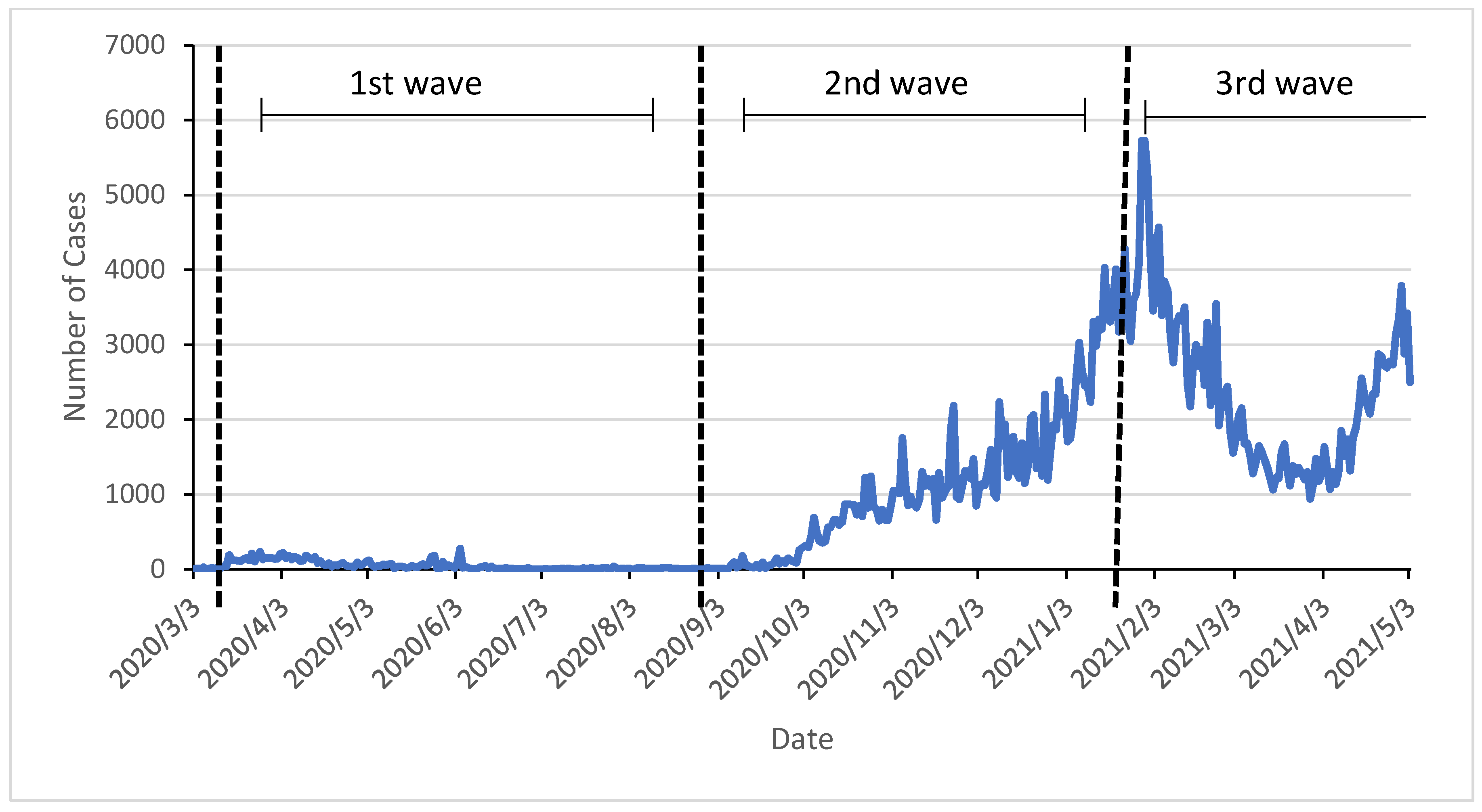

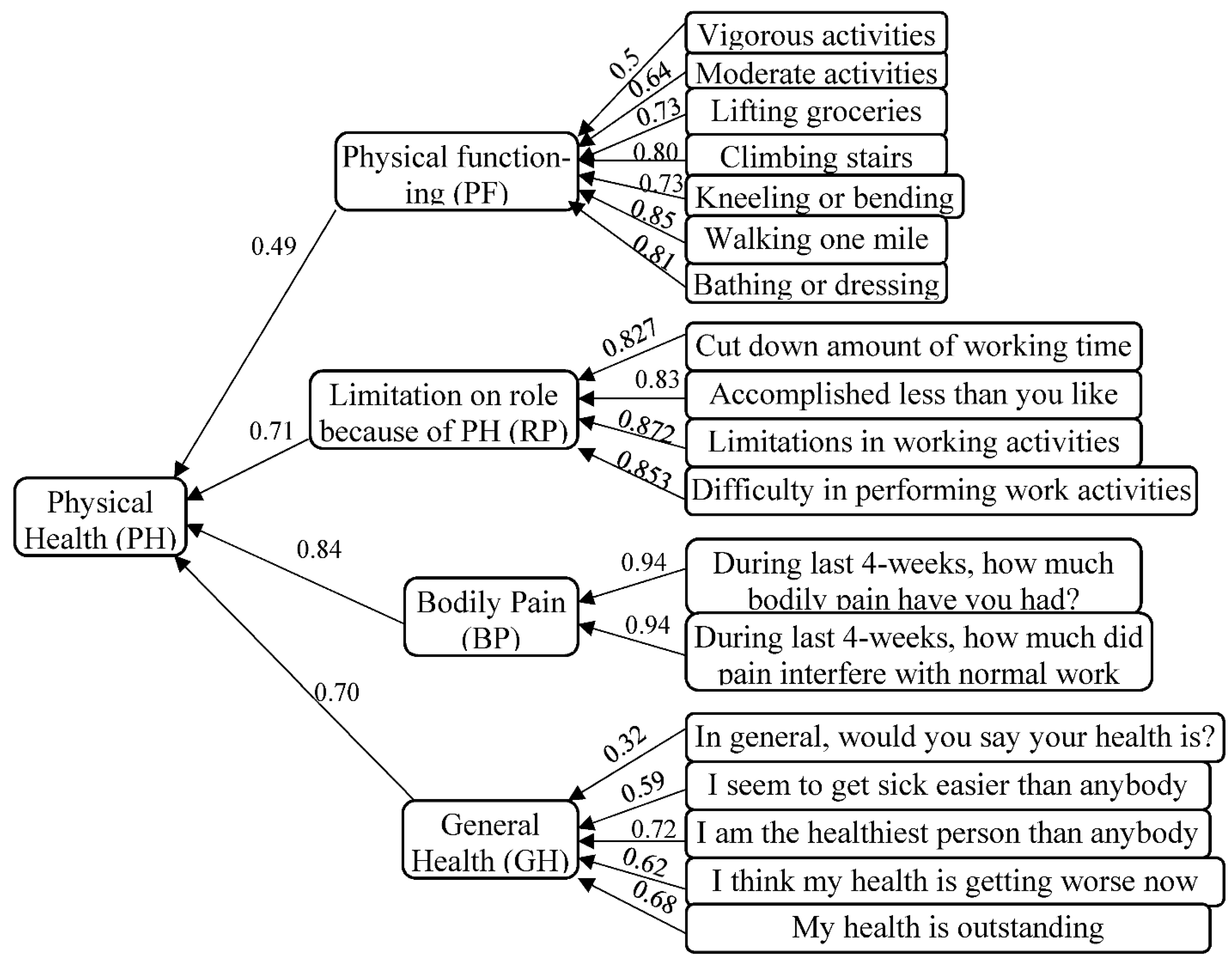

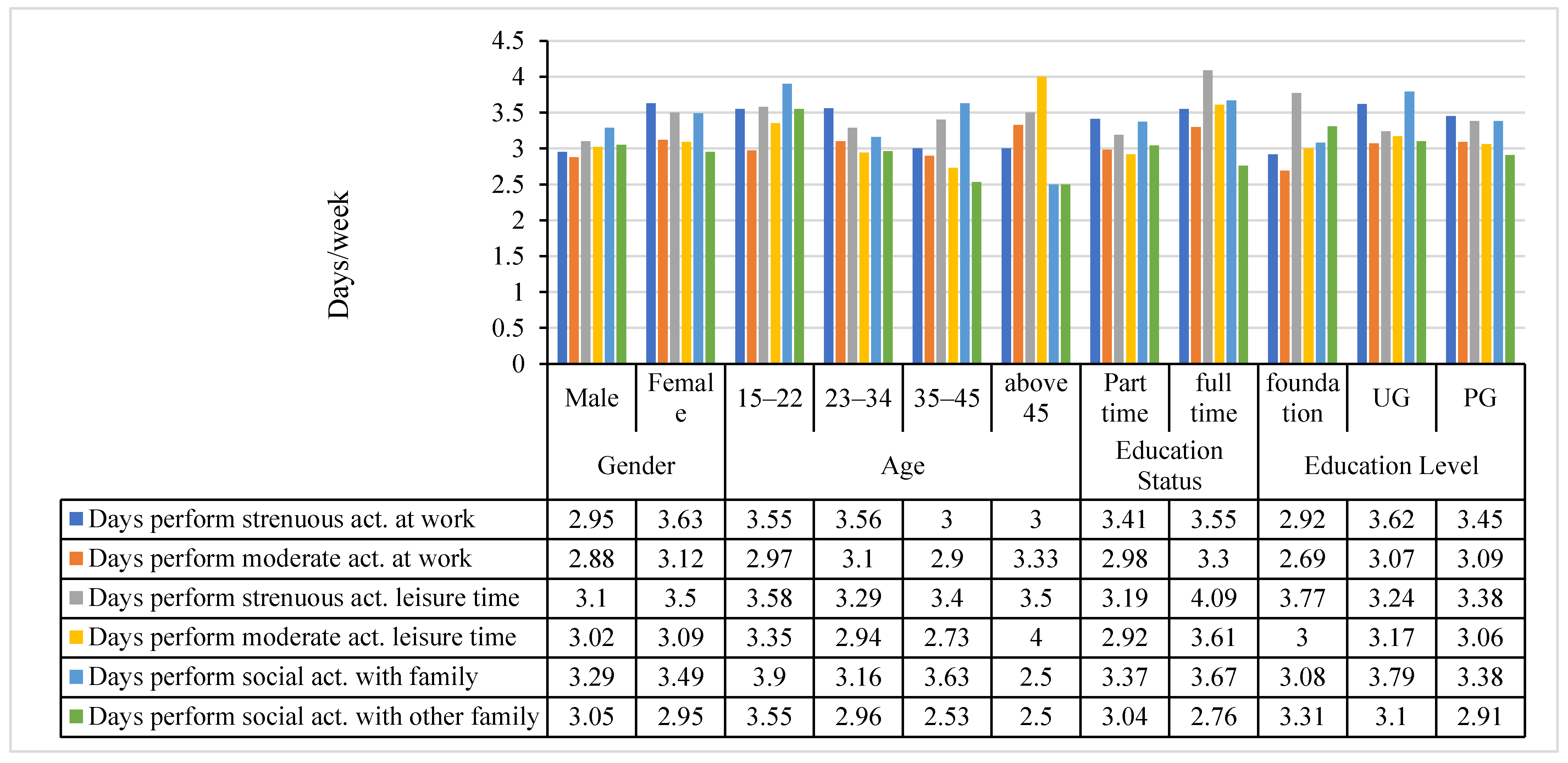

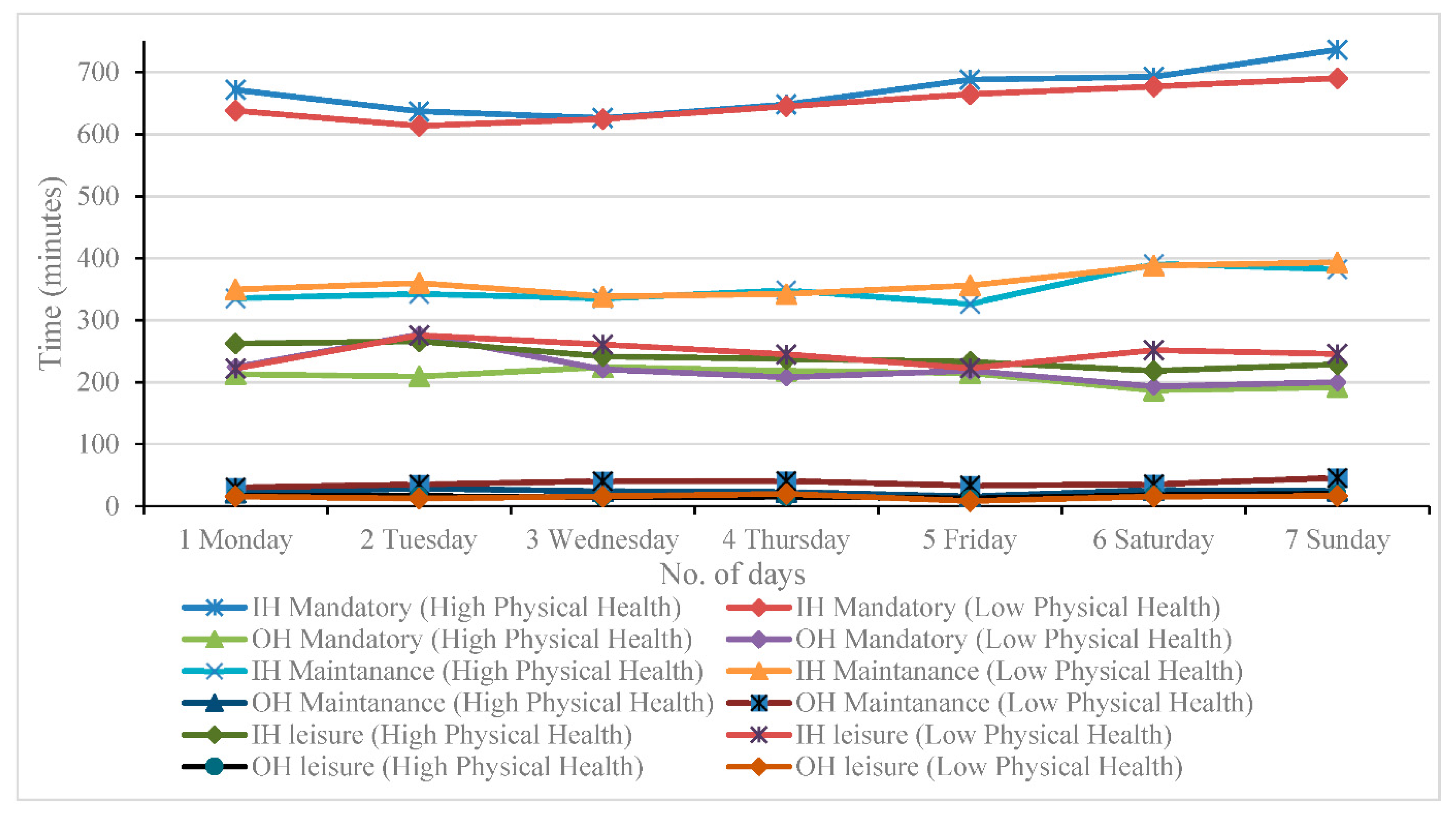
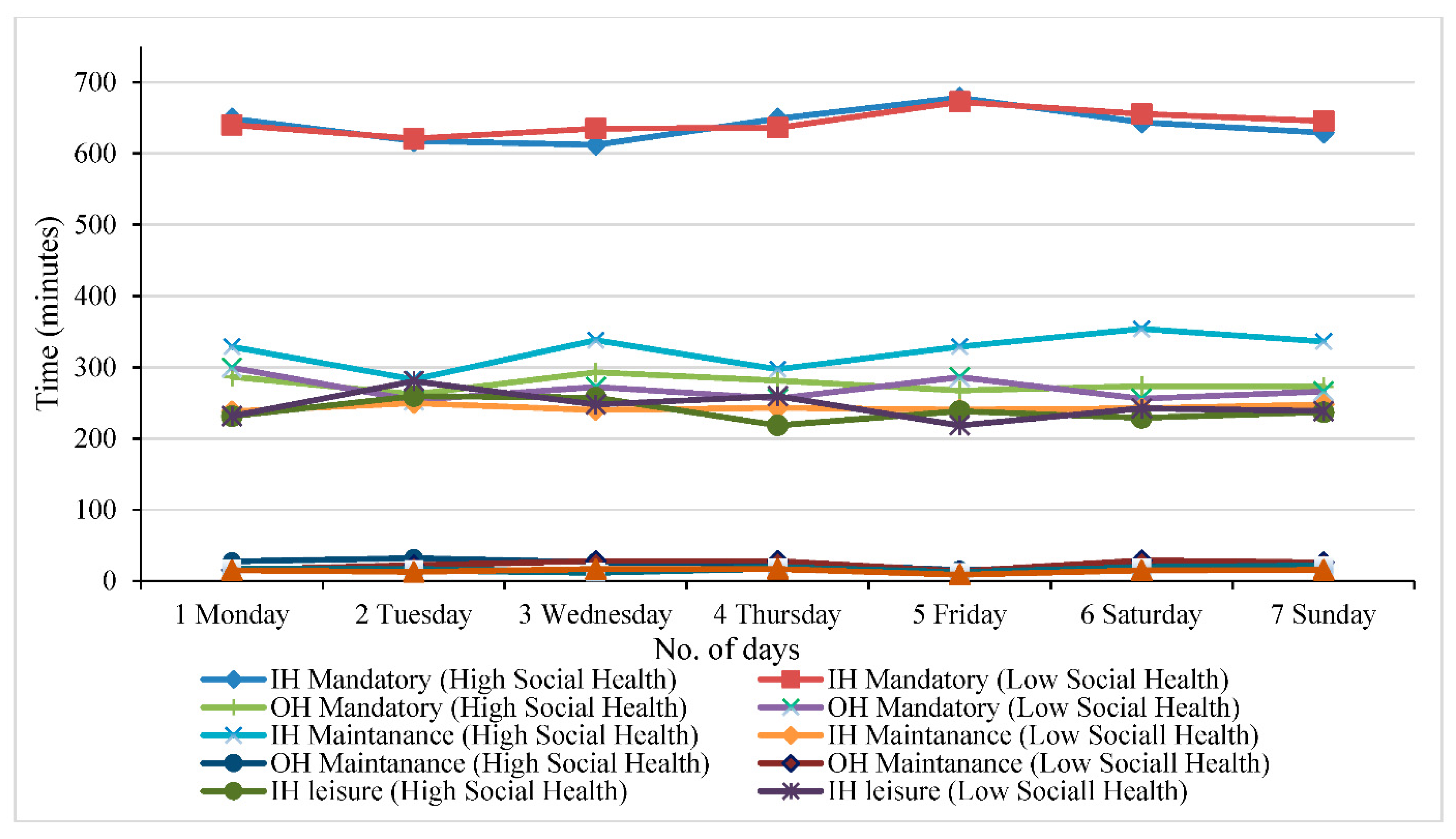
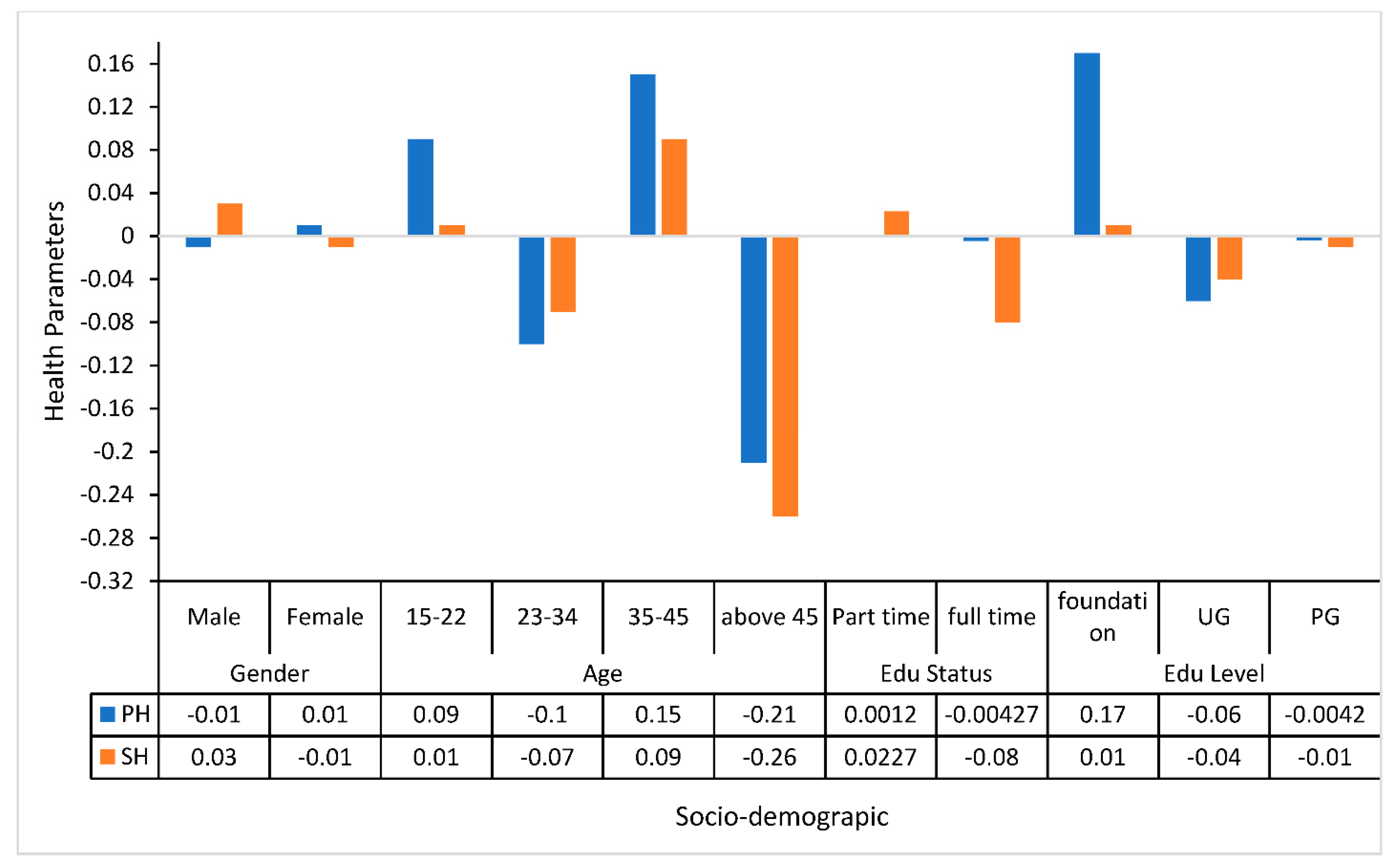

| Variables | Percentage/Mean | |
|---|---|---|
| Socio–Demographic Characteristics | ||
| Male | 72% | |
| Female | 28% | |
| Age 15–22 (years old) | 20.7% | |
| Age 23–34 (years old) | 52.7% | |
| Age 35–45 (years old) | 20% | |
| Above 45 (years old) | 6.7% | |
| Full-time study | 78% | |
| Part-time study | 22% | |
| Foundation students | 8.7% | |
| Undergraduate students | 19.3% | |
| Postgraduate students | 72% | |
| Intensity of physical activity at work | Days/Frequency | Duration |
| Strenuous-intensity physical activity at work | 3.44 | 38.33 |
| Moderate-intensity physical activity at work | 3.05 | 39.60 |
| Intensity of physical activity at leisure time | ||
| Strenuous-intensity physical activity at leisure time | 3.39 | 44.13 |
| Moderate-intensity physical activity at leisure time | 3.07 | 40.67 |
| Intensity of social activity within and with other family members | ||
| Social activity within family | 3.43 | 43.73 |
| social activity with other families | 2.98 | 42.00 |
| Travel parameters | ||
| Travel time by non-motorized mode | 3.65 | 24.23 |
| Travel time by motorized mode | 5.00 | 30.21 |
| Travel time by public transport | 4.57 | 29.67 |
| Percentage of using a non-motorized mode | 17.3% | |
| Percentage of using a motorized mode | 62.7% | |
| Percentage of using public transport | 20% | |
| Time spent on different activities on a given day on weekdays (Weekends) | ||
| Time spent on in-home mandatory activities (min) | 641.168 (644.47) | |
| Time spent on out-of-home mandatory activities (min) | 273.36 (268.08) | |
| Time spent on in-home leisure activities (min) | 244.63 (237.13) | |
| Time spent on out-of-home leisure activities (min) | 14.568 (17.27) | |
| Time spent on in-home maintenance activities (min) | 240.9 (249.4) | |
| Time spent on out-of-home maintenance activities (min) | 23.24 (25.35) | |
| Activity Criteria | Mandatory | Maintenance | Leisure | |||
| In-Home | Out-of-Home | In-Home | Out-of-Home | IN-Home | Out-of-Home | |
|
|
|
|
|
| |
| Variables | Moderate PA at Work | Strenuous PA at Work | PH at Work | SH at Work | ||||
|---|---|---|---|---|---|---|---|---|
| Value | t-Statt | Value | t-Statt | Value | t-Value | Value | t-Value | |
| Intercepts | 53.92 | 80.34 | 43.69 | 47.147 | 0.14 | 0.20 | −0.72 | −1.07 |
| Socio-demographic characteristics | ||||||||
| Male | 8.70 | 82.53 | 18.11 | 123.05 | - | - | −0.30 | −1.85 |
| Female | Ref | Ref | Ref | Ref | Ref | Ref | Ref | Ref |
| Below 22 | - | - | 1.649 | 4.896 | - | - | - | - |
| Below 34 | - | - | 0.735 | 2.793 | - | - | −0.17 | −2.76 |
| Below 45 | 6.04 | 29.87 | −8.26 | −29.368 | −0.32 | −2.84 | - | - |
| Above 45 | Ref | Ref | Ref | Ref | Ref | Ref | Ref | Ref |
| Foundation | - | - | - | - | - | - | - | - |
| Undergraduate | Ref | Ref | Ref | Ref | Ref | Ref | Ref | Ref |
| Postgraduate | - | - | 1.34 | 6.599 | 0.22 | 4.30 | 0.09 | 1.93 |
| Time-use and activity participation | ||||||||
| Time spent on in-home mandatory activities | 0.001 | −4.08 | 0.02 | 27.911 | 0.001 | 2.69 | - | - |
| Time spent on out-of-home mandatory activities | 0.001 | −8.34 | - | - | - | - | - | - |
| Time spent on in-home maintenance activities | 0.001 | −7.67 | - | - | - | - | - | - |
| Time spent on out-of-home maintenance activities | −0.05 | −32.17 | 0.004 | 2.048 | - | - | - | - |
| Daily travel parameters | ||||||||
| Using motorized mode for daily activity | −23.28 | −73.78 | −17.34 | −39.67 | - | - | 0.84 | 2.95 |
| Using non-motorized mode for daily activity | −22.69 | −61.39 | −27.05 | −52.39 | - | - | 0.96 | 2.95 |
| Using public transport for daily activity | Ref | Ref | Ref | Ref | Ref | Ref | Ref | Ref |
| Number of days using motorized transport | - | - | −0.15 | −3.158 | 0.02 | 1.85 | 0.03 | 2.94 |
| Number of days using non-motorized transport | −0.13 | −2.22 | −0.168 | −2.084 | - | - | −0.12 | −6.37 |
| Number of days using public transport | −4.27 | −50.48 | −0.237 | −2.015 | 0.09 | 1.68 | - | - |
| Min/day using motorized mode | 0.37 | 62.02 | 0.46 | 57.577 | −0.01 | −1.72 | −0.02 | −3.25 |
| Min/day using non-motorized mode | 0.46 | 52.83 | 0.49 | 40.45 | - | - | - | - |
| Min/day using public transport | 0.42 | 29.70 | 0.043 | 2.229 | −0.01 | −1.77 | 0.01 | 2.18 |
| Social, Political, and family participation within and with other families | ||||||||
| How many days within a week individual spends in social act | −2.16 | −59.68 | −2.75 | −55.80 | - | - | - | - |
| How long in a day individual spends time to do social activity | 0.22 | 73.81 | 0.16 | 43.60 | - | - | - | - |
| How many days in a week individual spends in social activities with other families and friends | −0.87 | −28.15 | −1.42 | −37.59 | - | - | - | - |
| How long in a day individual spends time doing social activities with other families and friends | - | - | 0.12 | 2.192 | ||||
| Endogenous of moderate-intensity PA at work | 0.02 | 1.76 | - | - | ||||
| Endogenous of strenuous-intensity PA at work | −0.02 | −2.69 | - | - | ||||
| Mean of dependent variables | 45.61 | 60.04 | 5.35 | 4.69 | ||||
| SD | 8.23 | 12.54 | 2.58 | 2.58 | ||||
| R-Square | 0.185 | 0.189 | 0.207 | 0.148 | ||||
| Independent random error term (εi) | 0.13 | 0.001 | 0.001 | 0.001 | ||||
| Individual specific error term | 1.41 | 1.97 | 0.48 | 0.45 | ||||
| AIC | 3762.59 | 4458.22 | 1483.42 | 1368.22 | ||||
| BIC | 3886.50 | 4577.18 | 1612.29 | 1497.09 | ||||
| Log-Likelihood | −1856.29 | −2205.11 | −715.71 | −658.11 | ||||
| Variables | Moderate PA at Leisure | Strenuous PA at Leisure | PH at Leisure | SH at Leisure | ||||
|---|---|---|---|---|---|---|---|---|
| Value | t-Statt | Value | t-Statt | Value | t-Statt | Value | t-Statt | |
| Intercepts | 56.34 | 39.67 | 30.78 | 10.54 | −0.23 | −0.76 | 0.49 | 1.72 |
| Socio-demographic characteristics | ||||||||
| Male | 3.04 | 13.53 | 3.15 | 6.82 | - | - | −0.06 | −1.82 |
| Female | Ref | Ref | Ref | Ref | Ref | Ref | Ref | Ref |
| Below 22 | −22.54 | −43.35 | −3.78 | −3.58 | 0.34 | 2.89 | - | - |
| Below 34 | −22.21 | −55.08 | −13.20 | −15.97 | - | - | −0.21 | −2.34 |
| Below 45 | −20.58 | −47.73 | - | - | 0.34 | 2.75 | −0.24 | −2.09 |
| Above 45 | Ref | Ref | Ref | Ref | Ref | Ref | Ref | Ref |
| Foundation | −6.76 | −17.06 | 10.34 | 12.69 | 0.38 | 3.99 | - | - |
| Undergraduate | Ref | Ref | Ref | Ref | Ref | Ref | Ref | Ref |
| Postgraduate | 3.76 | 11.83 | 2.21 | 3.44 | 0.11 | 2.03 | 0.12 | 2.35 |
| Time-use and activity participation | ||||||||
| Time spent on in-home mandatory activities | - | - | - | - | - | - | - | - |
| Time spent on out-of-home mandatory activities | - | - | - | - | - | - | - | - |
| Time spent on in-home maintenance activities | 0.00 | −2.34 | 0.02 | 6.28 | 0.005 | 1.92 | - | - |
| Time spent on out-of-home maintenance activities | - | - | 0.01 | 2.05 | - | - | - | - |
| Daily travel parameters | ||||||||
| Using motorized mode for daily activity | −20.52 | −30.50 | 14.67 | 10.60 | 0.85 | 4.62 | - | - |
| Using non-motorized mode for daily activity | −23.20 | −29.43 | −5.84 | −3.60 | - | - | 0.37 | 2.50 |
| Using public transport for daily activity | Ref | Ref | Ref | Ref | Ref | Ref | Ref | Ref |
| Number of days using motorized transport | −0.26 | −3.40 | 0.64 | 4.05 | 0.05 | 3.66 | 0.03 | 2.15 |
| Number of days using non-motorized transport | 0.43 | 3.51 | −0.53 | −2.08 | - | - | −0.12 | −6.31 |
| Number of days using public transport | 0.33 | 1.84 | −0.75 | −2.02 | - | - | −0.11 | −4.21 |
| Min/day using motorized mode | 0.53 | 41.52 | 0.17 | 6.52 | −0.02 | −6.40 | −0.01 | −2.13 |
| Min/day using non-motorized mode | 0.85 | 45.89 | 0.72 | 18.75 | - | - | 0.01 | 2.01 |
| Min/day using public transport | - | - | 0.14 | 2.23 | - | - | 0.02 | 4.36 |
| Social, Political, and family participation within and with other families | ||||||||
| How many days within a week individual spends in social act | 0.48 | 6.23 | 0.59 | 3.79 | - | - | −0.07 | −6.06 |
| How long in a day individual spends time to do social activity | −0.03 | −4.60 | −0.04 | −3.07 | - | - | 0.01 | 6.14 |
| How many days in a week individual spends in social activities with other families and friends | −0.26 | −3.99 | 0.86 | 7.23 | 0.04 | 2.27 | 0.09 | 4.24 |
| How long in a day individual spends time doing social activities with other families and friends | 0.24 | 40.88 | 0.39 | 7001625 | 0.08 | 5.32 | 0.12 | 4.83 |
| Endogenous of moderate-intensity PA at leisure | 0.02 | 3.66 | - | - | ||||
| Endogenous of strenuous-intensity PA at leisure | −0.02 | −4.59 | - | - | ||||
| Mean of dependent variables | 45.52 | 56.31 | 5.47 | 5.44 | ||||
| SD | 11.88 | 13.01 | 2.58 | 2.61 | ||||
| R-Square | 0.188 | 0.227 | 0.205 | 0.190 | ||||
| Independent random error term (εi) | 0.00 | 0.00 | 0.00 | 0.00 | ||||
| Individual specific error term | 3.02 | 6.20 | 0.48 | 0.45 | ||||
| AIC | 5347.54 | 6860.91 | 1472.94 | 1368.88 | ||||
| BIC | 5471.45 | 6979.87 | 1601.81 | 1497.75 | ||||
| Log-Likelihood | −2648.77 | −3406.46 | −710.47 | −658.44 | ||||
Publisher’s Note: MDPI stays neutral with regard to jurisdictional claims in published maps and institutional affiliations. |
© 2021 by the authors. Licensee MDPI, Basel, Switzerland. This article is an open access article distributed under the terms and conditions of the Creative Commons Attribution (CC BY) license (https://creativecommons.org/licenses/by/4.0/).
Share and Cite
Ali, M.; de Azevedo, A.R.G.; Marvila, M.T.; Khan, M.I.; Memon, A.M.; Masood, F.; Almahbashi, N.M.Y.; Shad, M.K.; Khan, M.A.; Fediuk, R.; et al. The Influence of COVID-19-Induced Daily Activities on Health Parameters—A Case Study in Malaysia. Sustainability 2021, 13, 7465. https://doi.org/10.3390/su13137465
Ali M, de Azevedo ARG, Marvila MT, Khan MI, Memon AM, Masood F, Almahbashi NMY, Shad MK, Khan MA, Fediuk R, et al. The Influence of COVID-19-Induced Daily Activities on Health Parameters—A Case Study in Malaysia. Sustainability. 2021; 13(13):7465. https://doi.org/10.3390/su13137465
Chicago/Turabian StyleAli, Mujahid, Afonso R. G. de Azevedo, Markssuel T. Marvila, Muhammad Imran Khan, Abdul Muhaimin Memon, Faisal Masood, Najib Mohammed Yahya Almahbashi, Muhammad Kashif Shad, Mudassir Ali Khan, Roman Fediuk, and et al. 2021. "The Influence of COVID-19-Induced Daily Activities on Health Parameters—A Case Study in Malaysia" Sustainability 13, no. 13: 7465. https://doi.org/10.3390/su13137465
APA StyleAli, M., de Azevedo, A. R. G., Marvila, M. T., Khan, M. I., Memon, A. M., Masood, F., Almahbashi, N. M. Y., Shad, M. K., Khan, M. A., Fediuk, R., Timokhin, R., Borovkov, A., & Haq, I. U. (2021). The Influence of COVID-19-Induced Daily Activities on Health Parameters—A Case Study in Malaysia. Sustainability, 13(13), 7465. https://doi.org/10.3390/su13137465










